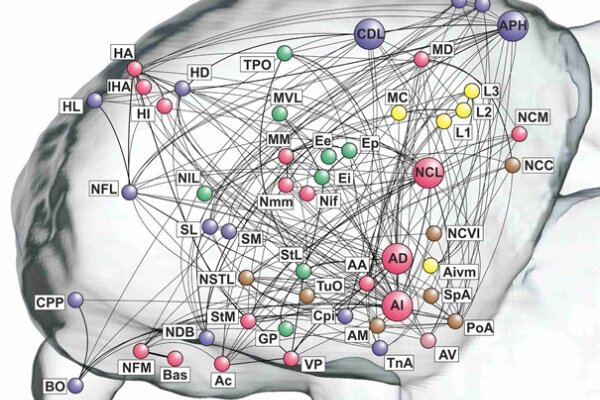2013-07-04

Many species of birds, including pigeons, possess demonstrable cognitive capacities, and some are even capable of cognitive feats matching those of apes. Since mammalian cortex is laminar while the avian telencephalon is nucleated, it is natural to ask whether the brains of these two cognitively capable taxa, despite their anatomical dissimilarities, might exhibit common principles of organisation on a deeper level. To find an answer to this question, a group of neuroanatomists and roboticists from Bochum, London, Auckland, Bowling Green, and Tampa came together to create the first large-scale "wiring diagram" for the forebrain of a bird. Using graph theory, they showed that, similar to mammals, the pigeon telencephalon is a modular, small-world network with a connective core of five inter-connected hub nodes that includes prefrontal-like and hippocampal structures. These regions are the most topologically central and most richly connected to the rest of the forebrain and thus central to information flow in the pigeon brain. Overall, their analysis suggests that indeed, despite the absence of cortical layers and close to 300 million years of separate evolution, the avian brain conforms to the same organisational principles as the mammalian brain on a topological level.

Many species of birds, including pigeons, possess demonstrable cognitive capacities, and some are even capable of cognitive feats matching those of apes. Since mammalian cortex is laminar while the avian telencephalon is nucleated, it is natural to ask whether the brains of these two cognitively capable taxa, despite their anatomical dissimilarities, might exhibit common principles of organisation on a deeper level. To find an answer to this question, a group of neuroanatomists and roboticists from Bochum, London, Auckland, Bowling Green, and Tampa came together to create the first large-scale "wiring diagram" for the forebrain of a bird. Using graph theory, they showed that, similar to mammals, the pigeon telencephalon is a modular, small-world network with a connective core of five inter-connected hub nodes that includes prefrontal-like and hippocampal structures. These regions are the most topologically central and most richly connected to the rest of the forebrain and thus central to information flow in the pigeon brain. Overall, their analysis suggests that indeed, despite the absence of cortical layers and close to 300 million years of separate evolution, the avian brain conforms to the same organisational principles as the mammalian brain on a topological level.